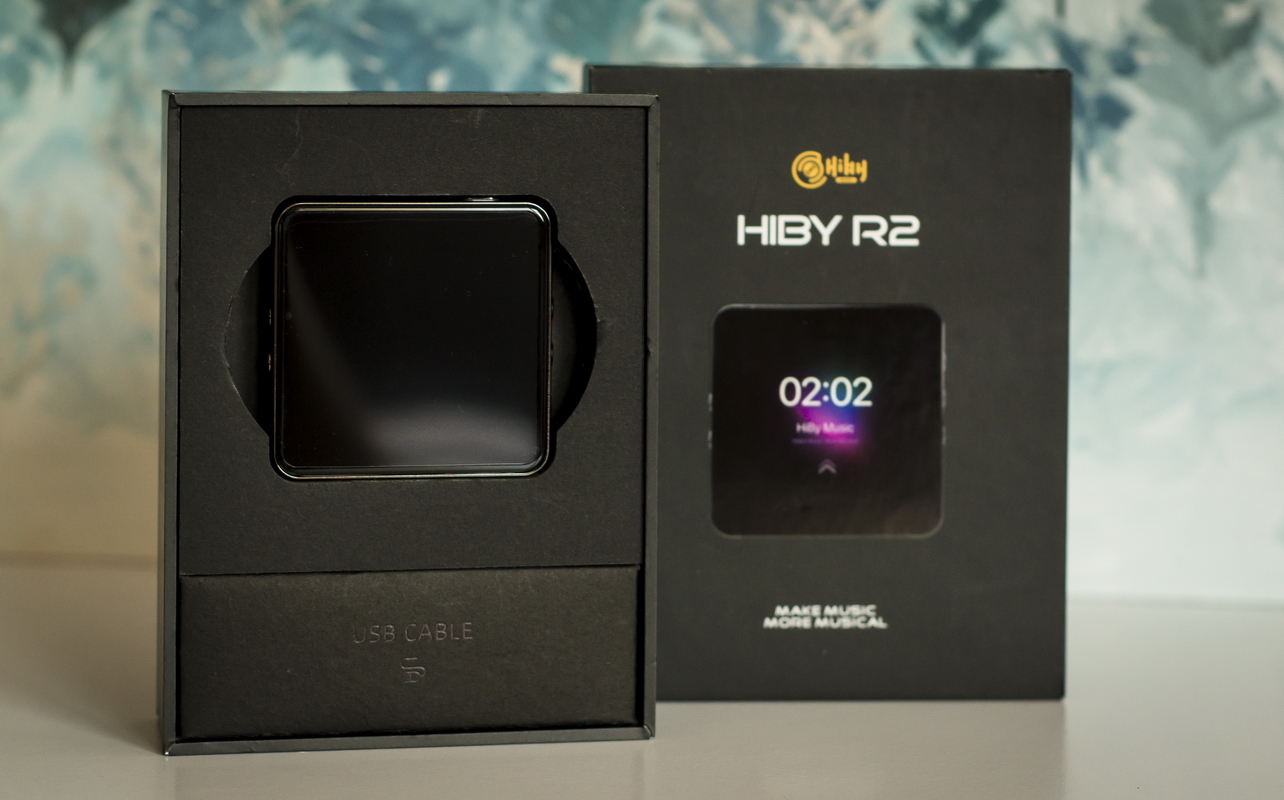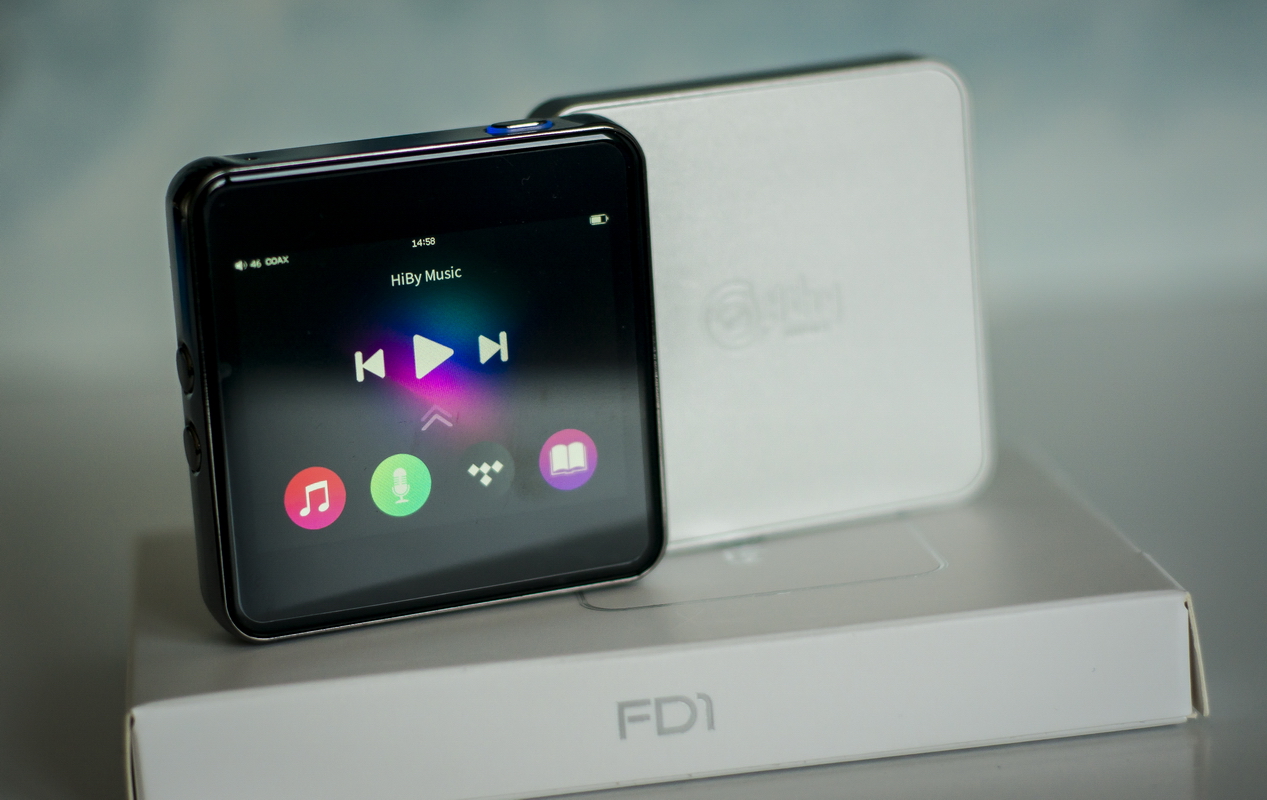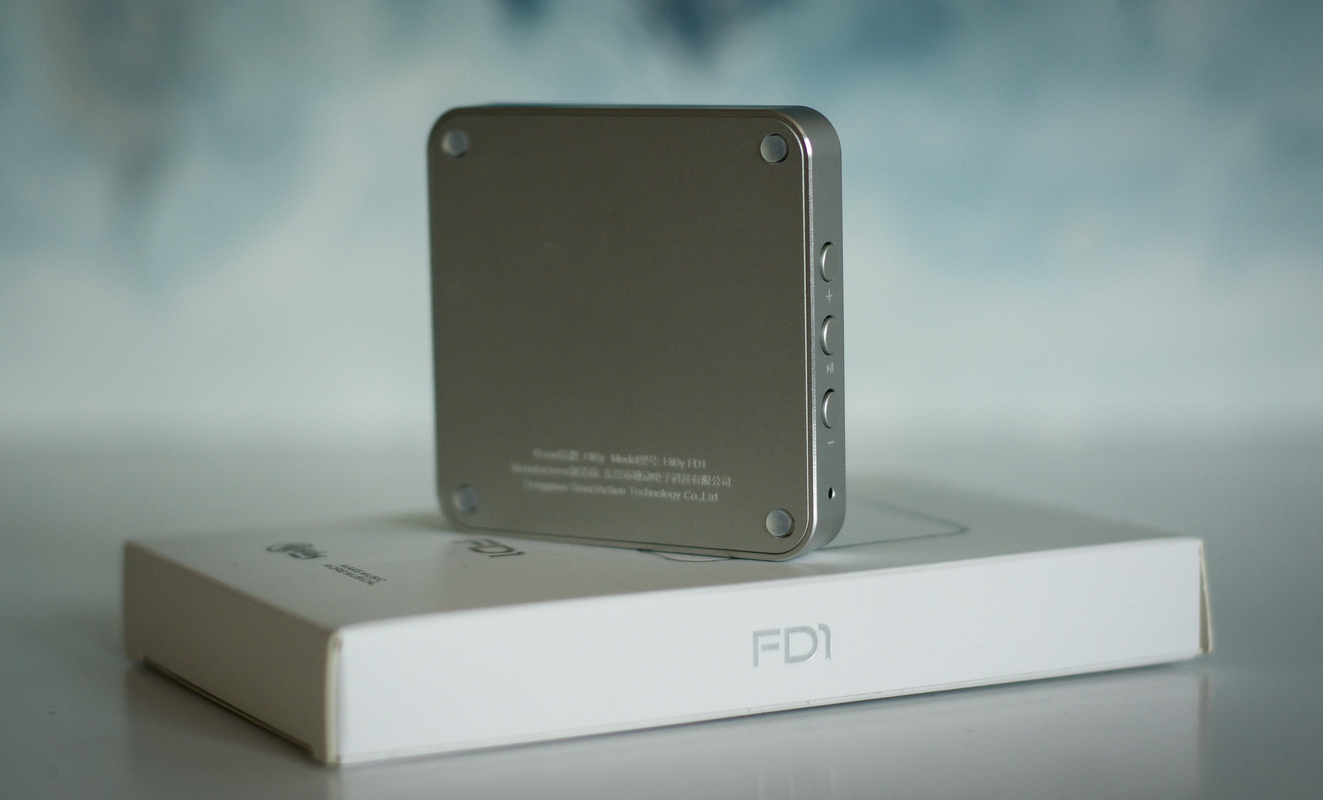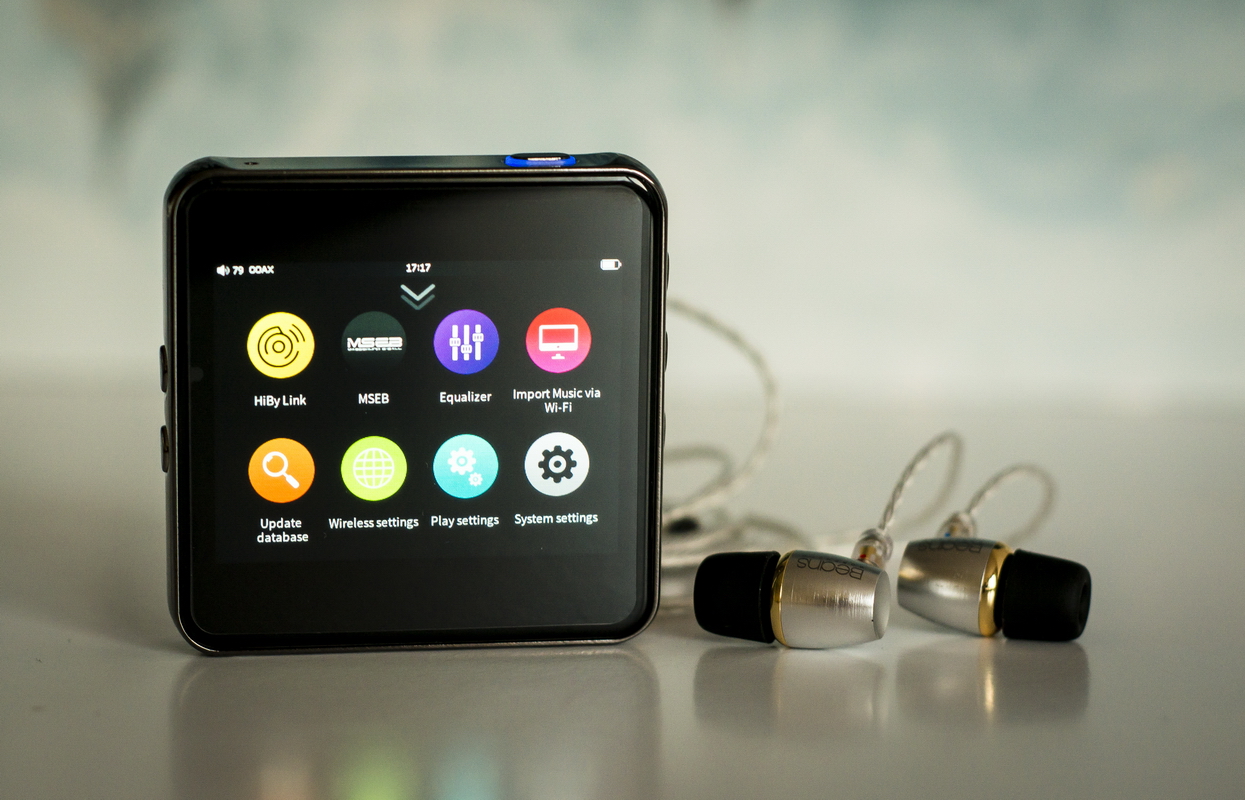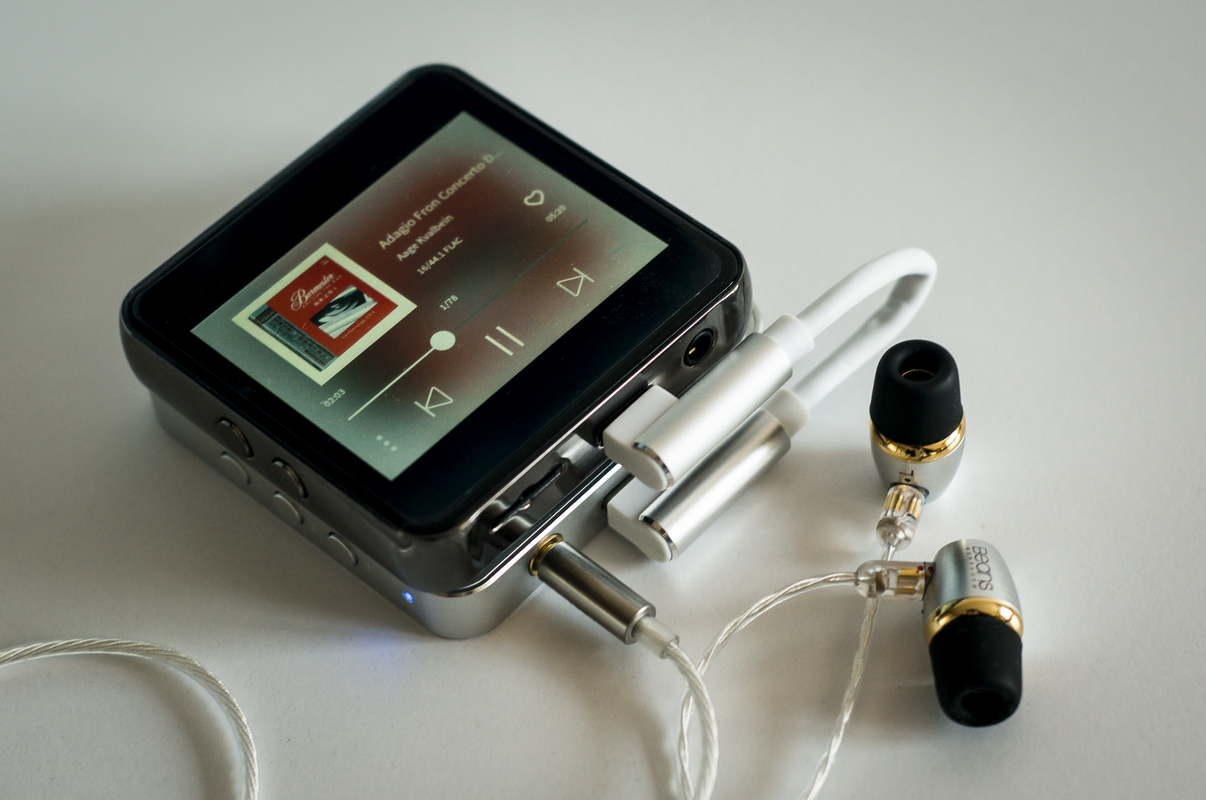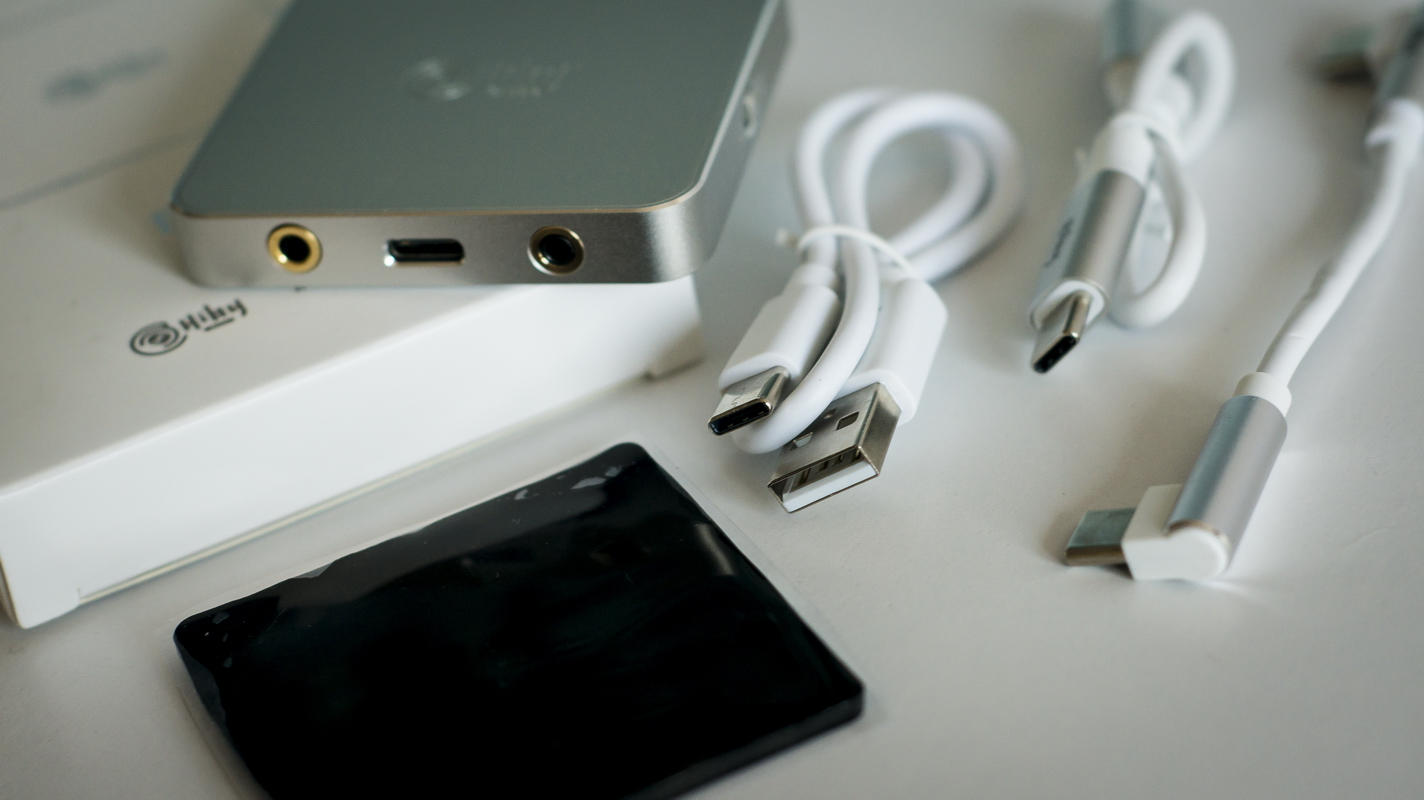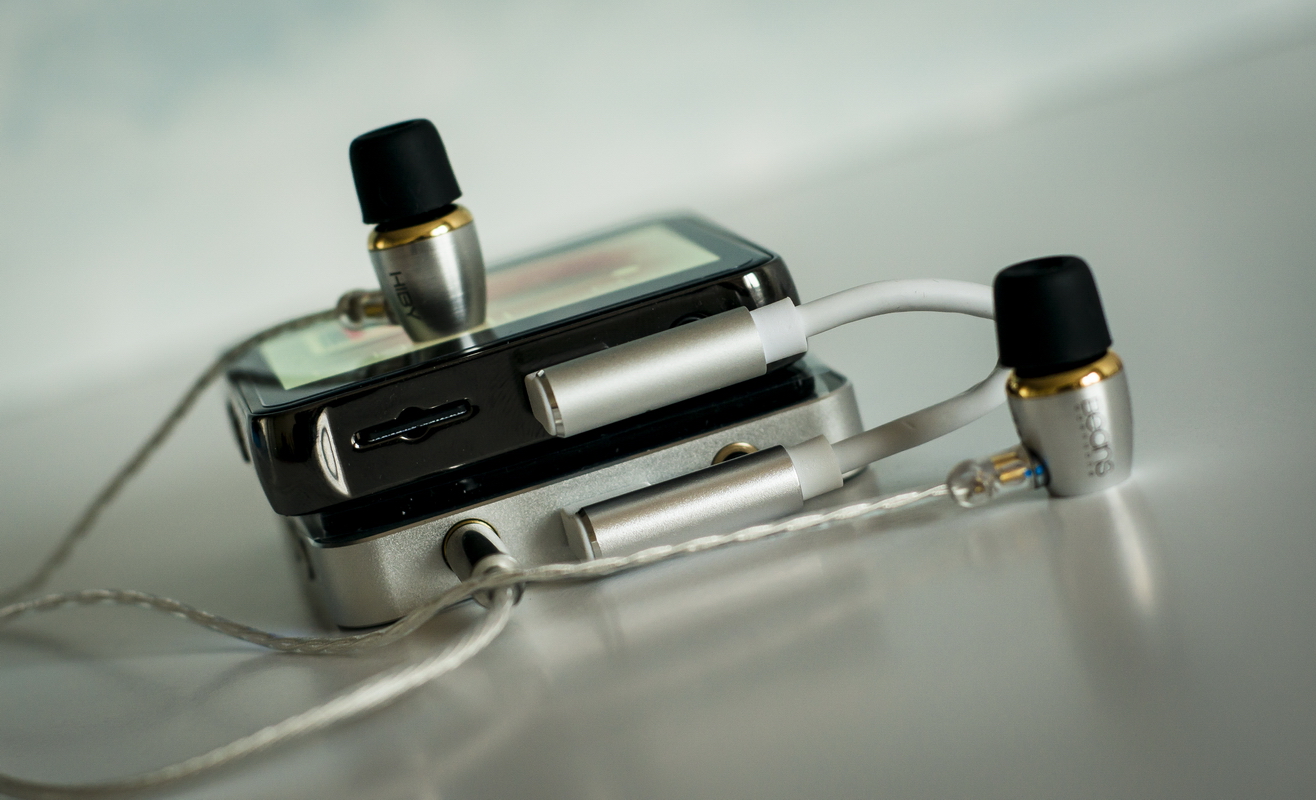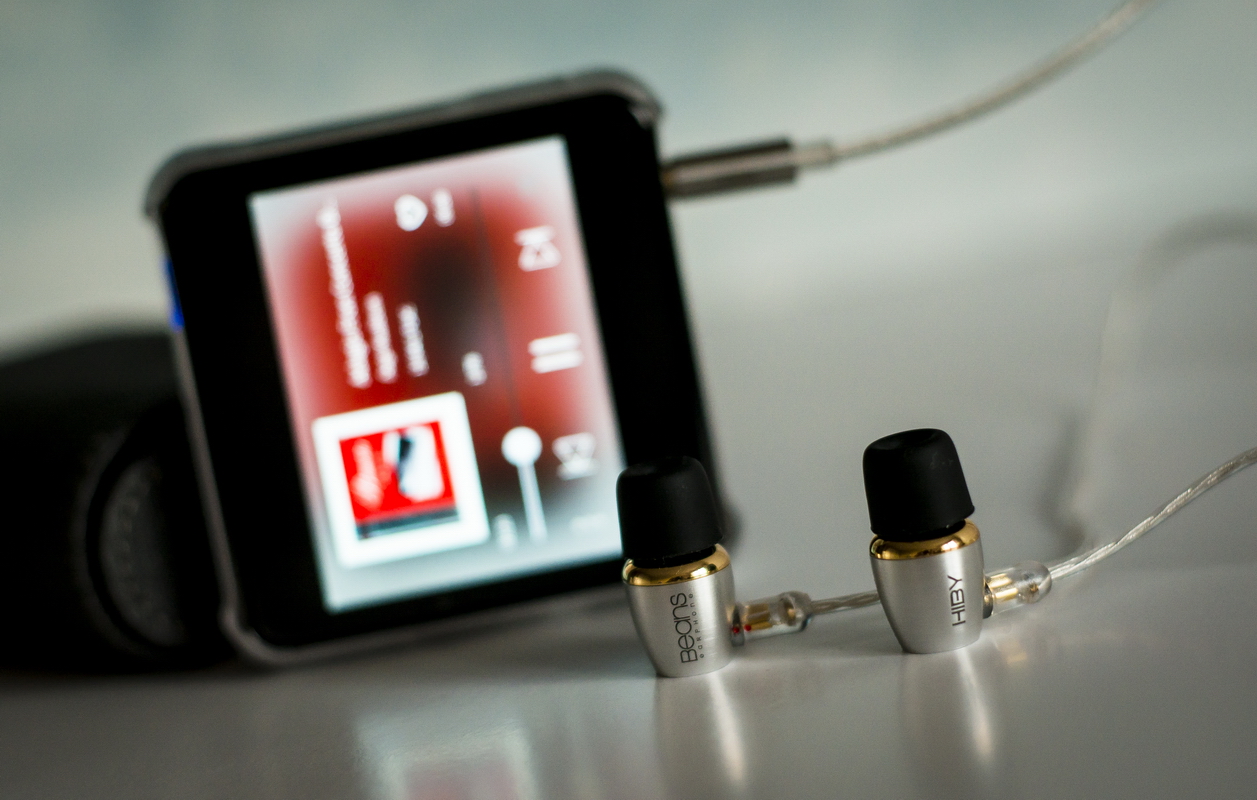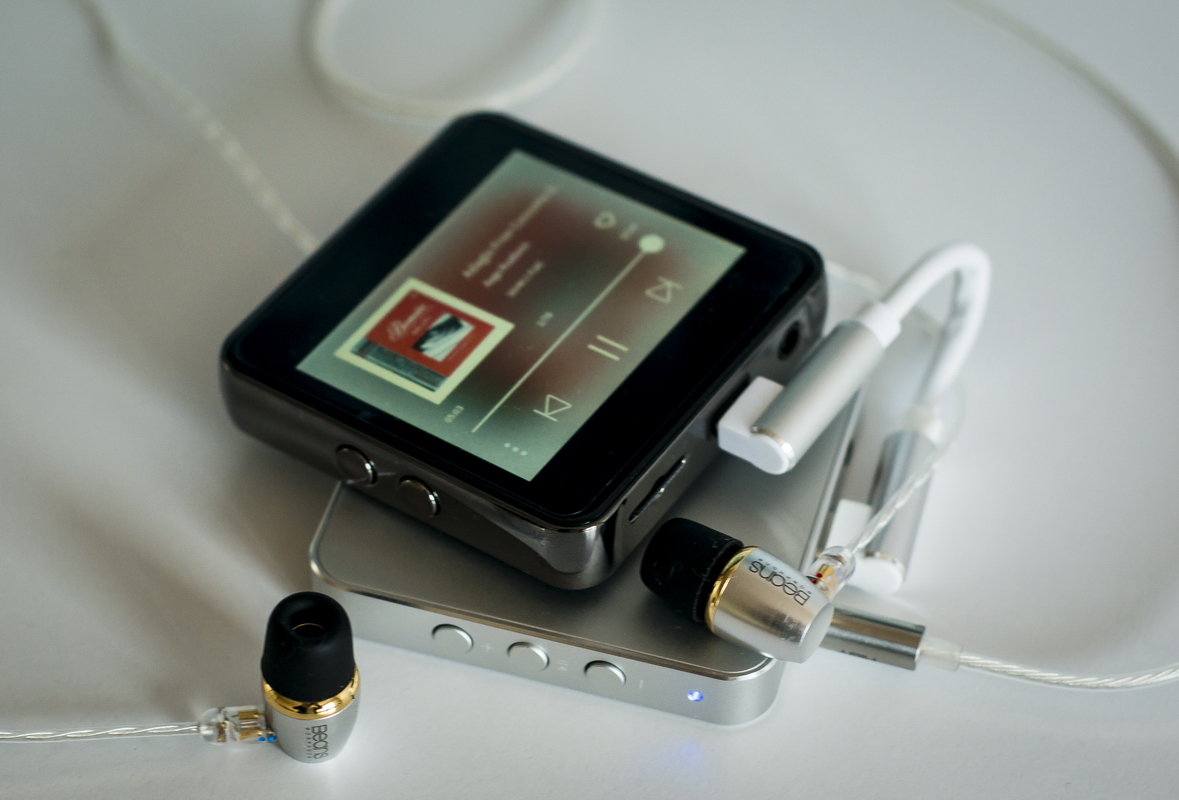Specifications



Operating System: HiBy OS
SoC: Ingenic X1000E
DAC: Sabre ESS ES9218
Dimensions: 61x61x12mm
Weight: 85g
Display size: 2.45”
Display resolution: 480x360
Battery capacity: 1000mAh
Storage: via MicroSD card slot supporting up to 2TB
USB Type-C USB2.0 port
Play time: 15h
Standby: 20 days
Bluetooth 5.0
Wi-Fi bands 2.4GHz, 5GH
Output power: 70mW+70mW
THD+N: <0.001%
Price: $99.
The R2 unit here was arranged by HiBy company for review.
Available directly from the HiBy site and MusicTeck store.
Design
The R2 is the new HiBy’s take for a small compact audio player. At the retail price of $99 it costs about half of the famous R3 models and still packs all the attractive features than none of its current rivals offer. Build quality is pretty solid with a new zinc alloy on the main chassis with glass panels on front and back sides. The zinc material is heavier than the usual aluminum used on most players, but as it is limited to the borders only it is still kept under the 100g mark, very close to the R3; for instance, the Shanling Q1 is much heavier with the zinc alloy used on the back side. It also maintains a very smooth finish like the R3 and R6. Both glass panels arrive with protective films attached to them, though the included plastic case is still recommended. The leather case is extra.
Unlike the higher Hiby players, the R2 has a square shape with all the needed buttons kept and logically placed with both audio and digital connections. The size is closer to the R3 than it is to ultra-portable players like the Shanling M0 and Fiio M5, but then the R2 offers a wider screen; it is on par with the Hidizs AP80, though still smaller than the Q1 and R3 screens.
The layout is the usual for Hiby devices. The left side has the two volume buttons and the right side the three playback buttons (previous/back, play/pause and next/forward). All the buttons are round and of the same size. The upper side only has a single button for power and screen that features the LED light that indicates the different player battery status and played file quality – it can be set off under system settings options if wished. There is a little rattling sound from the buttons.
The bottom part has the micro SD card slot to left and the USB Type-C port in the middle and audio 3.5mm to the right. There is no internal memory on the R2. The USB port works for charging, micro SD data management and also for digital audio input or output if used as DAC or connected as a playing source to external DAC. Also, the USB port can be used for external memory, accessible from the files menu.
As the R2 has a new voice recording feature there are two microphone holes, one to the right side and one at the top.
The touchscreen size is of 2.45”, and in spite of the square design of the player, the actual screen only occupies about 2/3 of the front panel’ height. It is a bit disappointing as it could have taken advantage of the larger size of the player for a more comfortable interface and higher resolution than its limited 480x360.
Inner hardware components follow the same Ingenic X1000E processor as the R3 models and a Sabre ESS ES9218 DAC chip (with 3 digital filters available). Like the R3 Pro, the R2 upgrades to Bluetooth 5.0 and 2.4G / 5GHz Wi-Fi bands for Tidal streaming and OTA firmware updates. Output power rates for 70mW (at 32Ω load) per channel with low and high gain options.
The battery of 1000mAh rates up to 15h of playback, though in practice it can be lower than that depending on the file quality, screen usage and brightness level. I could get about 12h with a mix of FLAC files and random screen use, so it is still a good standard for a small portable player; about the same as the AP80Pro and much better than the M0 and M5, but not as great as the R3 Pro and Q1. Luckily, charging time is quite fast. When the player is off, it displays the battery percentage but when on, only a little bar at the upper right corner of the screen.
Fortunately, the Bluetooth transmission works well on the R2 unit I received. The R2 features two-way BT, working both as transmitter and receiver, and in theory can handle even up to UAT, the highest codec so far developed by HiBy. I could only try up to AptX with wireless headphones and LDAC with BT Amp/Dac receivers. The audio quality is good enough, though the antenna is too sensitive to anything blocking the device.
User Interface & Software
The R2 runs on the own HiBy OS. It is different than on the R3, though, and it is presented in a more colorful theme with multiple tiles that can be quickly accessed through the main screen. The main home screen shows the current playing track with the three playback buttons. A swipe down from the upper part will bring extra switches for Bluetooth, Wi-Fi, HibyLink and Gain. There are 4 tiles on the main screen and a swipe up will bring to all the many extra options, 12 in total (8 per screen). Hiby music player and Tidal playback, settings for audio, system and wireless, standard and MSEB equalizers can be all easily accessed via this short menu. The system is stable enough, but I won’t get into much details of the whole options as I already found a few bugs or glitches on various screens. At the moment, the touch screen response is not very accurate, especially when trying to navigate or access the swipe menus, though it may be because of the screen protector film. Anyway, I would expect a decent firmware update as there hasn’t been any since I received the R2. The interface is still easy to understand, but you’re limited to only 3 rows (filenames) per screen when browsing through the Hiby player.
Sound Impressions
DAPs used: Shanling Q1, Hiby R3 Pro, Fiio M6 & M5, Hidizs AP80 Pro.
All the sound impressions are based with all EQ and MSEB options off.
The HiBy R2 is another take of the popular Sabre DAC ES9218 audio chip, found on several of the advanced small players and also a few wireless amp/dac, some of them even applied a dual set of chips for a balanced output. Needless to say, the actual sound depends on many other components and the final tuning that can vary from other players. And so is the case with this R2 when compared to some of its rivals such as the Shanking M0 & Q1, Hidizs AP80 players and Qudelix 5K Bluetooth Amp/DAC all with the same Sabre DAC chip, and yet sounding noticeably different.
The best way to describe the sound out of the R2 would smooth and mellow. It has a bit more added warmth and weight on the lower frequencies, making it the less neutral, balanced and transparent of the bunch. But that also makes it quite enjoyable and fun to pair with a different set of headphones, without losing on the level of details.
The boost on the lows is more specifically centered in the mid-bass area, while the sub-bass is not pronounced, limited in extension but very fair for the price range. The gain in body and weight is easily noticed when using neutral headphones (or north of) that do not have a very pronounced low-end, and specifically those with dynamic drivers. For example, RE2000, DK-3001, P55 Vento, all gain more density at the bass; a little less agile (not slow) but well textured. On the other hand, BA based IEMs, e.g. AM05 and R-220, didn’t get that improvement.
The midrange is thicker on the low-mids and misses a little of layering. The warmer tonality adds some fullness to the midrange and it sounds smoother, but less transparent. Upper midrange is slightly less highlighted compared to the lower midrange region but on the other hand, it is clearer and better separated. Smooth and relaxed maintaining a nice level air. The R2 is less edgy on the critical upper-mid/low-treble area, where sibilance is less noticed when compared to other players like the AP80 Pro, Q1, and M5 & M6. The treble keeps the smoother tuning and feels more laid-back and relaxed. The extension is very moderate and shows little amount of sparkle and less air, but in compensation it is more forgiving. The level of detail is not missing, just that it becomes less obvious. The soundstage is about average level with acceptable depth for the entry-level of the device.
As for comparisons, I’d pick the Shanling Q1 and Hidizs AP80 Pro – sharing the same Sabre DAC (dual on the AP80 Pro, but only one when used single-ended). The Q1 is more neutral and linear, and has the best balance among the three. It has a sharper separation, more air and finer layering with a bit wider stage, but in exchange sounds a little cooler in the midrange and sharper on the treble. The AP80 Pro would actually be the opposite of the R2, with less bass amount, leaner and more neutral up to the mids, with more emphasis on the highs (and upper mids). The bass on the AP80 is thinner and more plain, while on the R2 is more dynamic and better textured. The detail is more forward on the AP80 and shows more air.
An expected comparison would be against the upper Hiby model, the R3 Pro, which costs twice as much as the R2. I still find the R3 Pro the better in sound quality among all these compact players, while it is also the more expensive one. In terms of features the R2 packs everything the R3 Pro has and in a more colorful theme with all the convenient shortcuts. The R2 has a more specific sound presentation, more forgiving and very smooth, while the R3 Pro is balanced, more refined, accurate and capable of providing better driving power with a wider stage and more precise imaging.




Operating System: HiBy OS
SoC: Ingenic X1000E
DAC: Sabre ESS ES9218
Dimensions: 61x61x12mm
Weight: 85g
Display size: 2.45”
Display resolution: 480x360
Battery capacity: 1000mAh
Storage: via MicroSD card slot supporting up to 2TB
USB Type-C USB2.0 port
Play time: 15h
Standby: 20 days
Bluetooth 5.0
Wi-Fi bands 2.4GHz, 5GH
Output power: 70mW+70mW
THD+N: <0.001%
Price: $99.
The R2 unit here was arranged by HiBy company for review.
Available directly from the HiBy site and MusicTeck store.
Design
The R2 is the new HiBy’s take for a small compact audio player. At the retail price of $99 it costs about half of the famous R3 models and still packs all the attractive features than none of its current rivals offer. Build quality is pretty solid with a new zinc alloy on the main chassis with glass panels on front and back sides. The zinc material is heavier than the usual aluminum used on most players, but as it is limited to the borders only it is still kept under the 100g mark, very close to the R3; for instance, the Shanling Q1 is much heavier with the zinc alloy used on the back side. It also maintains a very smooth finish like the R3 and R6. Both glass panels arrive with protective films attached to them, though the included plastic case is still recommended. The leather case is extra.
Unlike the higher Hiby players, the R2 has a square shape with all the needed buttons kept and logically placed with both audio and digital connections. The size is closer to the R3 than it is to ultra-portable players like the Shanling M0 and Fiio M5, but then the R2 offers a wider screen; it is on par with the Hidizs AP80, though still smaller than the Q1 and R3 screens.
The layout is the usual for Hiby devices. The left side has the two volume buttons and the right side the three playback buttons (previous/back, play/pause and next/forward). All the buttons are round and of the same size. The upper side only has a single button for power and screen that features the LED light that indicates the different player battery status and played file quality – it can be set off under system settings options if wished. There is a little rattling sound from the buttons.
The bottom part has the micro SD card slot to left and the USB Type-C port in the middle and audio 3.5mm to the right. There is no internal memory on the R2. The USB port works for charging, micro SD data management and also for digital audio input or output if used as DAC or connected as a playing source to external DAC. Also, the USB port can be used for external memory, accessible from the files menu.
As the R2 has a new voice recording feature there are two microphone holes, one to the right side and one at the top.
The touchscreen size is of 2.45”, and in spite of the square design of the player, the actual screen only occupies about 2/3 of the front panel’ height. It is a bit disappointing as it could have taken advantage of the larger size of the player for a more comfortable interface and higher resolution than its limited 480x360.
Inner hardware components follow the same Ingenic X1000E processor as the R3 models and a Sabre ESS ES9218 DAC chip (with 3 digital filters available). Like the R3 Pro, the R2 upgrades to Bluetooth 5.0 and 2.4G / 5GHz Wi-Fi bands for Tidal streaming and OTA firmware updates. Output power rates for 70mW (at 32Ω load) per channel with low and high gain options.
The battery of 1000mAh rates up to 15h of playback, though in practice it can be lower than that depending on the file quality, screen usage and brightness level. I could get about 12h with a mix of FLAC files and random screen use, so it is still a good standard for a small portable player; about the same as the AP80Pro and much better than the M0 and M5, but not as great as the R3 Pro and Q1. Luckily, charging time is quite fast. When the player is off, it displays the battery percentage but when on, only a little bar at the upper right corner of the screen.
Fortunately, the Bluetooth transmission works well on the R2 unit I received. The R2 features two-way BT, working both as transmitter and receiver, and in theory can handle even up to UAT, the highest codec so far developed by HiBy. I could only try up to AptX with wireless headphones and LDAC with BT Amp/Dac receivers. The audio quality is good enough, though the antenna is too sensitive to anything blocking the device.
User Interface & Software
The R2 runs on the own HiBy OS. It is different than on the R3, though, and it is presented in a more colorful theme with multiple tiles that can be quickly accessed through the main screen. The main home screen shows the current playing track with the three playback buttons. A swipe down from the upper part will bring extra switches for Bluetooth, Wi-Fi, HibyLink and Gain. There are 4 tiles on the main screen and a swipe up will bring to all the many extra options, 12 in total (8 per screen). Hiby music player and Tidal playback, settings for audio, system and wireless, standard and MSEB equalizers can be all easily accessed via this short menu. The system is stable enough, but I won’t get into much details of the whole options as I already found a few bugs or glitches on various screens. At the moment, the touch screen response is not very accurate, especially when trying to navigate or access the swipe menus, though it may be because of the screen protector film. Anyway, I would expect a decent firmware update as there hasn’t been any since I received the R2. The interface is still easy to understand, but you’re limited to only 3 rows (filenames) per screen when browsing through the Hiby player.
Sound Impressions
DAPs used: Shanling Q1, Hiby R3 Pro, Fiio M6 & M5, Hidizs AP80 Pro.
All the sound impressions are based with all EQ and MSEB options off.
The HiBy R2 is another take of the popular Sabre DAC ES9218 audio chip, found on several of the advanced small players and also a few wireless amp/dac, some of them even applied a dual set of chips for a balanced output. Needless to say, the actual sound depends on many other components and the final tuning that can vary from other players. And so is the case with this R2 when compared to some of its rivals such as the Shanking M0 & Q1, Hidizs AP80 players and Qudelix 5K Bluetooth Amp/DAC all with the same Sabre DAC chip, and yet sounding noticeably different.
The best way to describe the sound out of the R2 would smooth and mellow. It has a bit more added warmth and weight on the lower frequencies, making it the less neutral, balanced and transparent of the bunch. But that also makes it quite enjoyable and fun to pair with a different set of headphones, without losing on the level of details.
The boost on the lows is more specifically centered in the mid-bass area, while the sub-bass is not pronounced, limited in extension but very fair for the price range. The gain in body and weight is easily noticed when using neutral headphones (or north of) that do not have a very pronounced low-end, and specifically those with dynamic drivers. For example, RE2000, DK-3001, P55 Vento, all gain more density at the bass; a little less agile (not slow) but well textured. On the other hand, BA based IEMs, e.g. AM05 and R-220, didn’t get that improvement.
The midrange is thicker on the low-mids and misses a little of layering. The warmer tonality adds some fullness to the midrange and it sounds smoother, but less transparent. Upper midrange is slightly less highlighted compared to the lower midrange region but on the other hand, it is clearer and better separated. Smooth and relaxed maintaining a nice level air. The R2 is less edgy on the critical upper-mid/low-treble area, where sibilance is less noticed when compared to other players like the AP80 Pro, Q1, and M5 & M6. The treble keeps the smoother tuning and feels more laid-back and relaxed. The extension is very moderate and shows little amount of sparkle and less air, but in compensation it is more forgiving. The level of detail is not missing, just that it becomes less obvious. The soundstage is about average level with acceptable depth for the entry-level of the device.
As for comparisons, I’d pick the Shanling Q1 and Hidizs AP80 Pro – sharing the same Sabre DAC (dual on the AP80 Pro, but only one when used single-ended). The Q1 is more neutral and linear, and has the best balance among the three. It has a sharper separation, more air and finer layering with a bit wider stage, but in exchange sounds a little cooler in the midrange and sharper on the treble. The AP80 Pro would actually be the opposite of the R2, with less bass amount, leaner and more neutral up to the mids, with more emphasis on the highs (and upper mids). The bass on the AP80 is thinner and more plain, while on the R2 is more dynamic and better textured. The detail is more forward on the AP80 and shows more air.
An expected comparison would be against the upper Hiby model, the R3 Pro, which costs twice as much as the R2. I still find the R3 Pro the better in sound quality among all these compact players, while it is also the more expensive one. In terms of features the R2 packs everything the R3 Pro has and in a more colorful theme with all the convenient shortcuts. The R2 has a more specific sound presentation, more forgiving and very smooth, while the R3 Pro is balanced, more refined, accurate and capable of providing better driving power with a wider stage and more precise imaging.






















